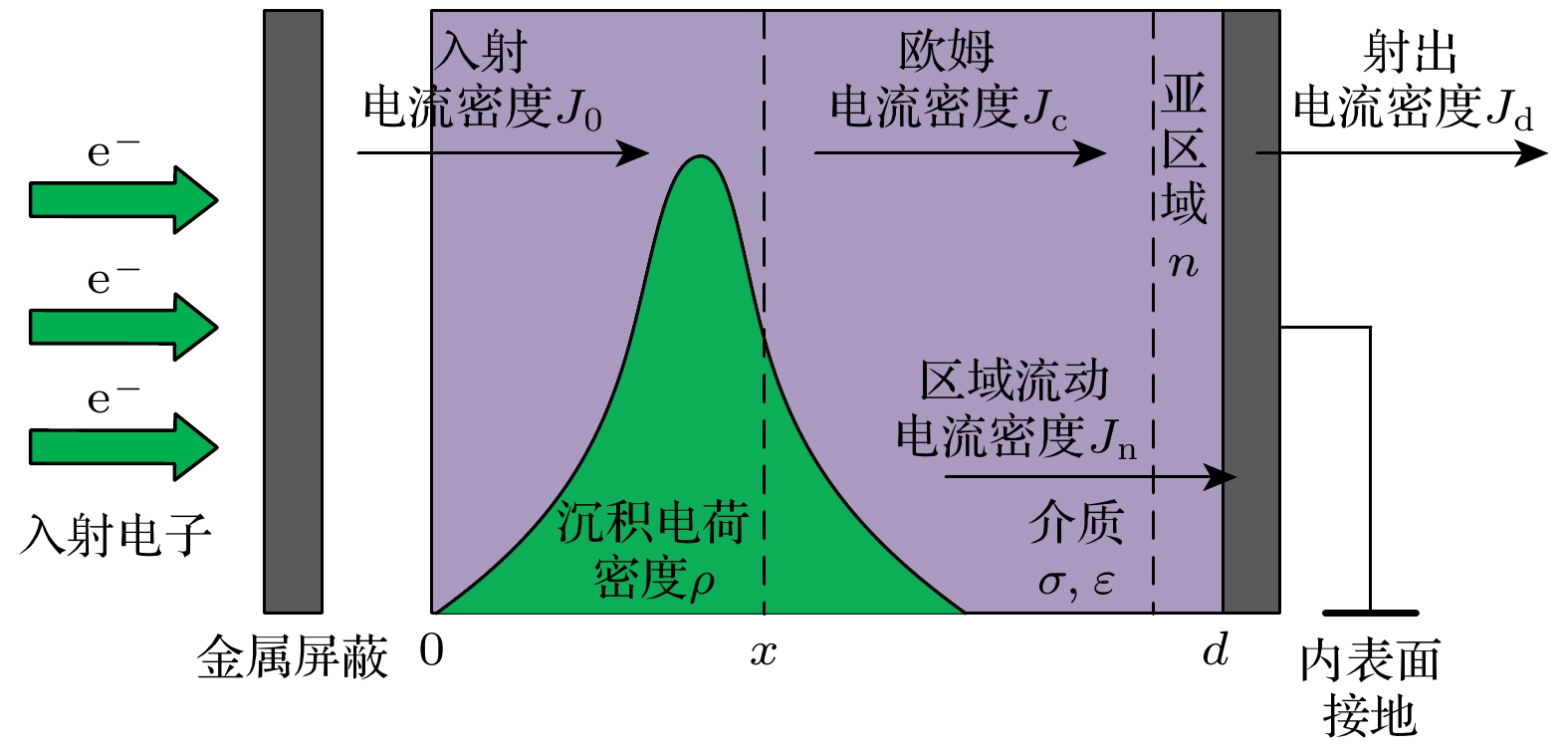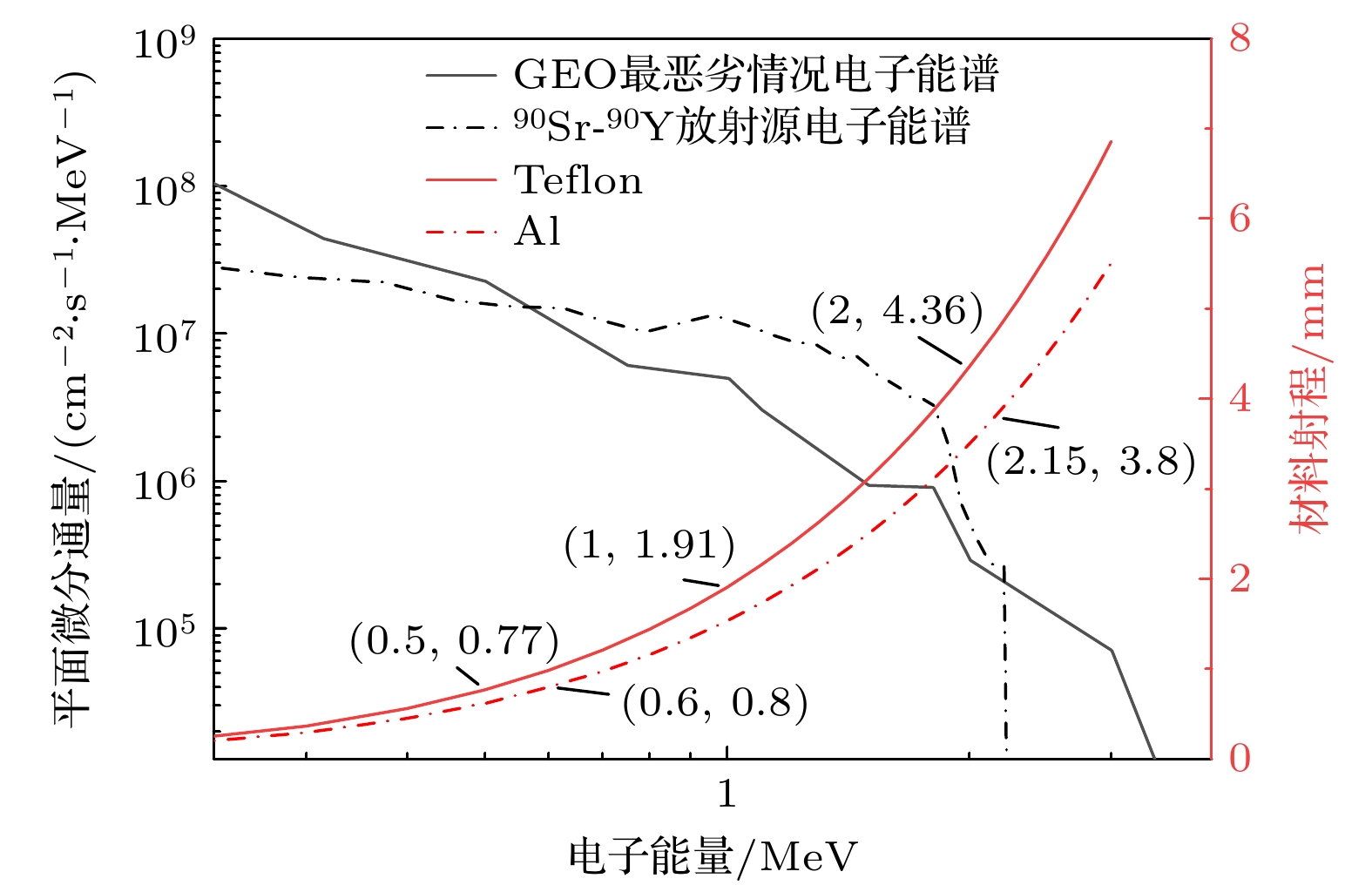-
高能电子引发的介质深层充放电效应, 是空间环境诱发地球同步轨道及中地球轨道航天器故障的重要原因之一. 地面模拟试验评估星用介质在轨深层充放电性能至关重要, 鉴于试验设备通常具有一定的局限性, 需开展对模拟试验评估的有效性进行分析. 本文介绍了介质深层充电的关键物理模型, 利用DICTAT程序, 仿真分析在相同的地球同步轨道应用遭遇的电子束流强度量级下, 锶源衰变电子、单能电子与地球同步轨道环境电子辐照聚四氟乙烯介质, 在舱表、舱内和单机内的3种不同屏蔽构型, 及不同介质厚度下的充电效果差异. 结果表明, 不同辐照条件下, 介质中沉积电子通量和介质接地处电子通量的差异是影响地球同步轨道充电效果的关键因素; 锶源可较有效模拟舱表和舱内介质的充电效果; 0.5 MeV单能束可较有效模拟舱表介质的充电效果. 为增强试验评估有效性, 给出了不同屏蔽下的试验束流条件建议.The deep charge-discharge effect in dielectrics induced by high-energy electrons is a major cause of spacecraft anomalies and failures in geosynchronous orbit (GEO) and medium earth orbit (MEO). To evaluate the in-orbit deep charging and discharging behavior of satellite dielectric materials, ground-based simulation testing is essential. However, due to limitations in ground test conditions, it is necessary to conduct a comprehensive analysis of the effectiveness of such evaluations. This paper introduces the key physical model of deep dielectric charging, taking a grounded planar dielectric with an irradiated inner surface as a representative case to analyze the internal charging process and the evolution of critical physical quantities governing deep charging phenomena. In this study, the DICTAT simulation tool is used to investigate the charging effects of three distinct electron sources: strontium-90 decay electrons, monoenergetic electron beams, and GEO ambient electrons. In ground-based simulations, researchers typically use monoenergetic or continuous-spectrum electron beams with flux intensities on the order of pA·cm–2 to irradiate test specimens with varying shielding configurations, dielectric thicknesses, and material compositions, aiming to replicate in-situ deep charging phenomena and assess associated risks. Therefore, the simulations are conducted under electron flux levels representative of GEO orbital conditions. This study focuses on polytetrafluoroethylene (PTFE) dielectric samples under three typical spacecraft shielding configurations: 1) externally mounted on the cabin surface, 2) housed inside the pressurized cabin, and 3) embedded within standalone electronic subsystems, while systematically incorporating variations in dielectric thickness. The results show that the disparity between the electron flux deposited within the dielectric bulk and the flux at dielectric interfaces critically governs the severity of charging under varying irradiation conditions. Two key findings emerge as follows. 1) Discrepancies in electron energy spectra and their influence: the differences in energy spectra between the test electron source and the actual space environment lead to variations in deposited electron flux across different aluminum shielding thicknesses and dielectric depths. This discrepancy influences the equilibrium charging state by changing the current density and conductivity in sub-region-n (the dielectric-ground interface), potentially resulting in either underestimation or overestimation of deep charging effects compared with true space conditions. 2) Effectiveness of different electron sources for simulation: strontium-based sources (e.g. Sr-90 β-decay spectra) effectively replicate the internal charging behavior of Teflon (PTFE) materials on cabin exteriors and inside pressurized compartments under GEO-like electron flux conditions. 0.5 MeV monoenergetic electron beams are suitable for simulating surface dielectric charging on cabin exteriors. However, higher-energy monoenergetic beams exhibit limited applicability at varying dielectric thicknesses. Despite the similar flux intensity used in the tests compared with that in the actual space environment, the differences in energy distribution between the test beams and space electrons can lead to underestimation or overestimation of the charging effects. Based on the simulation results, this work provides recommendations for selecting appropriate test beam parameters under different shielding conditions to improve the accuracy of ground-based evaluations of in-orbit deep dielectric charging.
-
Keywords:
- deep dielectric charging /
- DICTAT simulation /
- electron flux /
- experimental beam current recommendation
[1] Fennell J F, Koons H C, Roeder J L, Blake J B 2001 Spacecraft Charging: Observations and Relationship to Satellite Anomalies Aerospace Report TR-2001(8570)-5 (El Segundo CA: The Aerospace Corporation) pp2–6
[2] 黄建国, 韩建伟 2010 59 2907
 Google Scholar
Google Scholar
Huang J G, Han J W 2010 Acta Phys. Sin. 59 2907
 Google Scholar
Google Scholar
[3] 刘尚合, 胡小锋, 原青云, 谢喜宁 2019 高电压技术 45 2108
 Google Scholar
Google Scholar
Liu S H, Hu X F, Yuan Q Y, Xie X N 2019 High Volt. Eng. 45 2108
 Google Scholar
Google Scholar
[4] Wei D J, Zhu L Y, Wu J W, Tong Z A, Xia S W, Lin J Y 2023 IEEE Trans. Plasma Sci. 51 3384
 Google Scholar
Google Scholar
[5] Fennell J F, Koons H C, Chen M W, Blake J B 2000 IEEE Trans. Plasma Sci. 28 2029
 Google Scholar
Google Scholar
[6] Garrett H B, Whittlesey A C 2012 Guide to Mitigating Spacecraft Charging Effects (Hoboken: Wiley) pp25–35
[7] Yu X Q, Chen H F, Zong Q G, Wang J Z, Shi W H, Zou H, Zou J Q, Zhong W Y, Chen Z, Shao S P, Jia X H 2016 IEEE Trans. Nucl. Sci. 63 1306
 Google Scholar
Google Scholar
[8] 韩建伟, 张振龙, 黄建国, 全荣辉, 李小银 2007 航天器环境工程 24 47
Han J W, Zhang Z L, Huang J G, Quan R H, Li X Y 2007 Spacecraft Environ. Eng. 24 47
[9] 张振龙, 韩建伟, 全荣辉, 安广朋 2009 航天器环境工程 26 210
 Google Scholar
Google Scholar
Zhang Z L, Han J W, Quan R H, An G P 2009 Spacecraft Environ. Eng. 26 210
 Google Scholar
Google Scholar
[10] Paulmier T, Dirassen B, Payan D, Van Eesbeek M 2009 IEEE Trans. Dielectr. Electr. Insul. 16 682
 Google Scholar
Google Scholar
[11] 刘继奎, 张可墨, 柳青, 王松, 王斌, 国锋 2018 高电压技术 44 864
 Google Scholar
Google Scholar
Liu J K, Zhang K M, Liu Q, Wang S, Wang B, Guo F 2018 High Volt. Eng. 44 864
 Google Scholar
Google Scholar
[12] Molinie P, Dessante P, Hanna R, Paulmier T, Dirassen B, Belhaj M, Payan D, Balcon N 2012 IEEE Trans. Dielectr. Electr. Insul. 19 1215
 Google Scholar
Google Scholar
[13] 陈伟, 杨海亮, 郭晓强, 姚志斌, 丁李利, 王祖军, 王晨辉, 王忠明, 丛培天 2017 科学通报 62 978
Chen W, Yang H L, Guo X Q, Yao Z B, Ding L L, Wang Z J, Wang C H, Wang Z M, Cong P T 2017 Sci. Bull. 62 978
[14] Sorensen J, Rodgers D J, Ryden K A, Latham P M, Wrenn G L, Levy L, Panabiere G 2000 IEEE Trans. Nucl. Sci. 47 491
 Google Scholar
Google Scholar
[15] 黄建国, 陈东 2004 53 1611
 Google Scholar
Google Scholar
Huang J G, Chen D 2004 Acta Phys. Sin. 53 1611
 Google Scholar
Google Scholar
[16] 黄建国, 陈东 2004 地球 47 392
 Google Scholar
Google Scholar
Huang J G, Chen D 2004 Chin. J. Geophys. 47 392
 Google Scholar
Google Scholar
[17] Adamec V, Calderwood J H 1975 J. Phys. D: Appl. Phys. 8 551
 Google Scholar
Google Scholar
[18] SPENVIS (Space Environment Effects and Education System), ESA https://www.spenvis.oma.be/ [2025-2-17]
[19] NASA Office of the Chief Engineer 2022 NASA-HDBK-4002B: Mitigating In-Space Charging Effects—A Guideline (Washington D. C. : NASA) pp37–105
[20] Weber K H 1963 Nucl. Instrum. Methods 25 261
 Google Scholar
Google Scholar
[21] Sørensen J 1996 Proceedings of the ESA Symposium on Environment Modelling for Space-Based Applications Noordwijk, Netherlands, June 10–12, 1996 p129
[22] Plis E A, Engelhart D P, Likar J, Hoffmann R C, Cooper R, Ferguson D 2018 J. Spacecr. Rockets 55 775
 Google Scholar
Google Scholar
[23] DuPont 2022 Kapton® Summary of Properties (Wilmington: DuPont) pp10–11
[24] McAlees M 2000 Raw Material Challenges and New Technology Innovations in Pressure Sensitive Tape (Circleville: DuPont) pp294–298
-
图 3 Teflon在不同铝屏蔽下相同空间束流强度的各电子能谱辐射充电效果与介质厚度关系 (a) 无屏蔽; (b) 0.8 mm铝屏蔽; (c) 3.8 mm铝屏蔽
Fig. 3. Relation between the radiation charging effect of each electron energy spectrum of Teflon with the same spatial beam intensity and the thickness of the medium under different aluminum shielding: (a) No shielding; (b) 0.8 mm aluminium shield; (c) 3.8 mm aluminum shield.
图 4 无屏蔽Teflon在相同空间束流强度的各电子能谱辐射下亚区域n电流密度和电阻率与介质厚度关系 (a) 流动电流密度; (b) 总电阻率
Fig. 4. Relationship between sub-region current density and resistivity and dielectric thickness of unshielded Teflon under different electron energy spectrum radiation with the same spatial beam intensity: (a) Flow current density; (b) total resistivity.
图 6 单能束电子条件与GEO环境电子辐射8种介质材料的充电效果对比关系 (a) 无屏蔽; (b) 0.8 mm铝屏蔽; (c) 3.8 mm铝屏蔽
Fig. 6. Comparison of charging effects of eight dielectric materials under single-energy beam electron conditions and GEO environmental electron radiation: (a) No shielding; (b) 0.8 mm aluminium shield; (c) 3.8 mm aluminum shield.
表 1 介质材料的物理性能参数
Table 1. Physical performance parameters of the dielectric materials.
电介质 Teflon Mylar Plexiglas Cmxglass Polythene Expoy Etfe Kapton kp/(Ω–1·cm–1·rad–1·s) 2.0×10–16 3.0×10–20 2.2×10–17 1.0×10–16 4.5×10–16 6.5×10–16 2.0×10–16 1.0×10–15 σ/(Ω–1·m–1) 1.0×10–16 1.0×10–16 1.0×10–15 1.0×10–13 1.0×10–14 2.5×10–15 1.0×10–16 1.0×10–15 Δ 0.7 0.8 1.0 1.0 0.8 1.0 0.8 0.6 ρ/(g·cm–3) 2.17 1.4 1.2 2.61 0.93 1.5 1.7 1.42 εr/(F·m–1) 2.15 3.0 4.0 3.8 2.26 3.6 2.5 3.45 -
[1] Fennell J F, Koons H C, Roeder J L, Blake J B 2001 Spacecraft Charging: Observations and Relationship to Satellite Anomalies Aerospace Report TR-2001(8570)-5 (El Segundo CA: The Aerospace Corporation) pp2–6
[2] 黄建国, 韩建伟 2010 59 2907
 Google Scholar
Google Scholar
Huang J G, Han J W 2010 Acta Phys. Sin. 59 2907
 Google Scholar
Google Scholar
[3] 刘尚合, 胡小锋, 原青云, 谢喜宁 2019 高电压技术 45 2108
 Google Scholar
Google Scholar
Liu S H, Hu X F, Yuan Q Y, Xie X N 2019 High Volt. Eng. 45 2108
 Google Scholar
Google Scholar
[4] Wei D J, Zhu L Y, Wu J W, Tong Z A, Xia S W, Lin J Y 2023 IEEE Trans. Plasma Sci. 51 3384
 Google Scholar
Google Scholar
[5] Fennell J F, Koons H C, Chen M W, Blake J B 2000 IEEE Trans. Plasma Sci. 28 2029
 Google Scholar
Google Scholar
[6] Garrett H B, Whittlesey A C 2012 Guide to Mitigating Spacecraft Charging Effects (Hoboken: Wiley) pp25–35
[7] Yu X Q, Chen H F, Zong Q G, Wang J Z, Shi W H, Zou H, Zou J Q, Zhong W Y, Chen Z, Shao S P, Jia X H 2016 IEEE Trans. Nucl. Sci. 63 1306
 Google Scholar
Google Scholar
[8] 韩建伟, 张振龙, 黄建国, 全荣辉, 李小银 2007 航天器环境工程 24 47
Han J W, Zhang Z L, Huang J G, Quan R H, Li X Y 2007 Spacecraft Environ. Eng. 24 47
[9] 张振龙, 韩建伟, 全荣辉, 安广朋 2009 航天器环境工程 26 210
 Google Scholar
Google Scholar
Zhang Z L, Han J W, Quan R H, An G P 2009 Spacecraft Environ. Eng. 26 210
 Google Scholar
Google Scholar
[10] Paulmier T, Dirassen B, Payan D, Van Eesbeek M 2009 IEEE Trans. Dielectr. Electr. Insul. 16 682
 Google Scholar
Google Scholar
[11] 刘继奎, 张可墨, 柳青, 王松, 王斌, 国锋 2018 高电压技术 44 864
 Google Scholar
Google Scholar
Liu J K, Zhang K M, Liu Q, Wang S, Wang B, Guo F 2018 High Volt. Eng. 44 864
 Google Scholar
Google Scholar
[12] Molinie P, Dessante P, Hanna R, Paulmier T, Dirassen B, Belhaj M, Payan D, Balcon N 2012 IEEE Trans. Dielectr. Electr. Insul. 19 1215
 Google Scholar
Google Scholar
[13] 陈伟, 杨海亮, 郭晓强, 姚志斌, 丁李利, 王祖军, 王晨辉, 王忠明, 丛培天 2017 科学通报 62 978
Chen W, Yang H L, Guo X Q, Yao Z B, Ding L L, Wang Z J, Wang C H, Wang Z M, Cong P T 2017 Sci. Bull. 62 978
[14] Sorensen J, Rodgers D J, Ryden K A, Latham P M, Wrenn G L, Levy L, Panabiere G 2000 IEEE Trans. Nucl. Sci. 47 491
 Google Scholar
Google Scholar
[15] 黄建国, 陈东 2004 53 1611
 Google Scholar
Google Scholar
Huang J G, Chen D 2004 Acta Phys. Sin. 53 1611
 Google Scholar
Google Scholar
[16] 黄建国, 陈东 2004 地球 47 392
 Google Scholar
Google Scholar
Huang J G, Chen D 2004 Chin. J. Geophys. 47 392
 Google Scholar
Google Scholar
[17] Adamec V, Calderwood J H 1975 J. Phys. D: Appl. Phys. 8 551
 Google Scholar
Google Scholar
[18] SPENVIS (Space Environment Effects and Education System), ESA https://www.spenvis.oma.be/ [2025-2-17]
[19] NASA Office of the Chief Engineer 2022 NASA-HDBK-4002B: Mitigating In-Space Charging Effects—A Guideline (Washington D. C. : NASA) pp37–105
[20] Weber K H 1963 Nucl. Instrum. Methods 25 261
 Google Scholar
Google Scholar
[21] Sørensen J 1996 Proceedings of the ESA Symposium on Environment Modelling for Space-Based Applications Noordwijk, Netherlands, June 10–12, 1996 p129
[22] Plis E A, Engelhart D P, Likar J, Hoffmann R C, Cooper R, Ferguson D 2018 J. Spacecr. Rockets 55 775
 Google Scholar
Google Scholar
[23] DuPont 2022 Kapton® Summary of Properties (Wilmington: DuPont) pp10–11
[24] McAlees M 2000 Raw Material Challenges and New Technology Innovations in Pressure Sensitive Tape (Circleville: DuPont) pp294–298
计量
- 文章访问数: 1560
- PDF下载量: 35
- 被引次数: 0














 下载:
下载:





